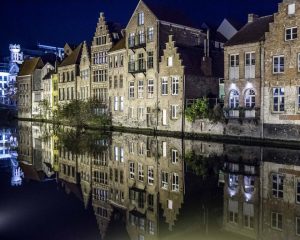
Information about activities and events in Ghent can be found on the VISIT GENT page. Inoformation about Ghent University is provided here.
Short history of Ghent (quoted from the Visit Ghent page)
The history of Ghent begins in the year 630 when St Amandus chose the site of the confluence (or ‘Ganda’) of the two rivers, the Lys and the Scheldt to construct an abbey. Nearly 1400 years of history are still palpable in the city today: a medieval castle surrounded by a moat, an imposing cathedral, a belfry, three beguinages… Nowhere else does one find so much history per square metre than in the historical heart of Ghent!
From the year 1000 to around 1550, Ghent was one of the most important cities in Europe. It was bigger than London and second only to Paris in size. The 60,000 inhabitants it had in the 14th century clung forcefully to their rights: earls and princes discovered that the proud and rebellious people of Ghent would not relinquish their hard-won privileges and freedoms without a fight.
Until the Battle of the Golden Spurs in 1302, the city was ruled by a number of rich merchant families. Because they mostly chose the side of the French king against the Count of Flanders, the people gave them the nickname ‘Leliaerts’, derived from the lily on the French coat of arms. As the trades and guilds gained more political power in the 14th century, Ghent came to acquire a more democratic government.
Because England blocked the import of raw materials for the vitally important textile industry, Ghent was forced, by sheer necessity, to take England’s side (1338-1345) during the Hundred Years’ War. Jacob van Artevelde, a rich cloth merchant, led the uprising against Count Louis de Nevers, the vassal of the French king. In 1345, this ‘wise man’ was murdered by his fellow citizens. His importance is shown by the fact that Ghent is still called the ‘City of Artevelde’.
Ghent had to give up its ties with England and embrace the king of France. In 1407 the seat of the Council of Flanders, the highest judicial body in the county, was moved from Bruges to the Castle of the Counts. Since then Dutch became the official language.
Over the centuries the inhabitants of Ghent remained true to their reputation of being headstrong and awkward. They even rebelled against their own child prince, Charles V. But that was a bridge too far: the citizens of Ghent were publicly humiliated and the Klokke Roeland, the symbol of Ghent’s independence, was removed from the Belfry. The once powerful city-state had literally and figuratively fallen to its knees.
The economic situation also gradually worsened. The city lost its passage to the sea and the population decreased by half. Only in the second half of the 18th century was there an economic revival. In 1816, under Dutch administration, Ghent acquired its own university. As a commemoration, a statue of king William I of the Netherlands, founder of the University, was unveiled on Reep. Ten years later the city again became a sea port thanks to the Ghent-Terneuzen canal.
Nevertheless, Ghent still continued to sail against the tide: during Belgium’s independence struggle many inhabitants remained loyal to the Dutch House of Orange. Ghent later became the continent’s first large industrial centre. As a result, it was here that the socialist movement and the first trade union associations appeared.
In 1913, Ghent showed its best side during the World Exhibition. Because it suffered little bomb damage during the two world wars, Ghent’s historical heritage has remained largely intact right up to the present.